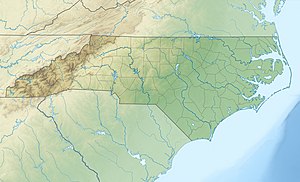Roaring Fork is a 5.84 mi (9.40 km) long 3rd order tributary to the Fisher River in Surry County, North Carolina.
| Roaring Fork Tributary to Fisher River | |
|---|---|
| Location | |
| Country | United States |
| State | North Carolina |
| County | Surry Alleghany |
| Physical characteristics | |
| Source | Ramey Creek divide |
| • location | about 2 miles south-southwest of High Point Spur |
| • coordinates | 36°31′17″N 080°55′32″W / 36.52139°N 80.92556°W[1] |
| • elevation | 2,730 ft (830 m)[2] |
| Mouth | Fisher River |
• location | about 1 mile south of Lowgap, North Carolina |
• coordinates | 36°30′17″N 080°51′20″W / 36.50472°N 80.85556°W[1] |
• elevation | 1,258 ft (383 m)[2] |
| Length | 5.84 mi (9.40 km)[3] |
| Basin size | 13.09 square miles (33.9 km2)[4] |
| Discharge | |
| • location | Fisher River |
| • average | 21.99 cu ft/s (0.623 m3/s) at mouth with Fisher River[4] |
| Basin features | |
| Progression | Fisher River → Yadkin River → Pee Dee River → Winyah Bay → Atlantic Ocean |
| River system | Yadkin River |
| Tributaries | |
| • left | unnamed tributaries |
| • right | Ramey Creek |
| Bridges | Fishers Peak View, Carson Creek Road (x2), Ramey Creek Road (x2), Warrior Mountain Lane |
Course
editRoaring Fork rises on the divide of Ramey Creek about 2 miles south-southwest of High point Spur. Roaring Fork then flows generally southeast to join the Fisher River about 1 mile south of Lowgap, North Carolina.[2]
Watershed
editRoaring Fork drains 13.09 square miles (33.9 km2) of area, receives about 48.5 in/year of precipitation, has a wetness index of 272.01, and is about 74% forested.[4]
See also
editReferences
edit- ^ a b "GNIS Detail - Roaring Fork". geonames.usgs.gov. US Geological Survey. Retrieved 21 September 2020.
- ^ a b c "Lowgap Topo Map in Surry". TopoZone. Locality, LLC. Retrieved 21 September 2020.
- ^ "ArcGIS Web Application". epa.maps.arcgis.com. US EPA. Retrieved 21 September 2020.
- ^ a b c "Roaring Fork Watershed Report". US EPA Geoviewer. US EPA. Retrieved 21 September 2020.

